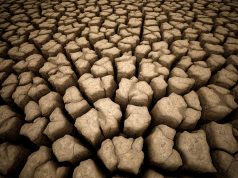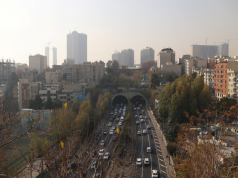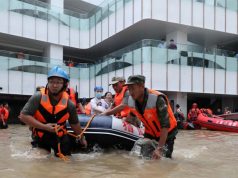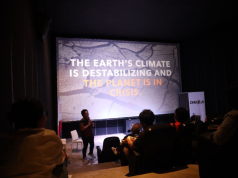
By the end of the 21st century, if nothing is done to limit greenhouse gas emissions that drive global warming, Filipinos will no longer be able to live outdoors due to extremely hot ambient temperatures.
This was the warning of climate expert Hans Joachim Schellnhuber, Director of the Potsdam Institute for Climate Impact Research (PIK) in Germany and a member of the Pontifical Academy of Sciences in the Vatican, and a winner of the Nobel Prize for Chemistry.
On Friday, he presented the report “A Region at Risk: The Human Dimensions of Climate Change in Asia and the Pacific” at the Asian Development Bank in Mandaluyong City.
This was the same day one of the biggest icebergs recorded was reported to have broken away from the Antarctica Ice Shelf.
How big is this new iceberg? Only roughly the size of Bali in Indonesia.
Based on a business-as-usual scenario, where nations continue to emit high emissions and international cooperation on climate mitigation fails, the Philippines, along with some of its neighbors in Southeast Asia, will someday experience deadly conditions due to extreme temperatures almost every day.
“All of the tropics will develop conditions that physiologically, humans cannot live outside anymore,” Schellnhuber said.
Modeling and simulations predict that temperatures will keep rising by 1.7 degrees Celsius above preindustrial levels by 2030, to 2.7 degrees by 2050, and up to 4 degrees by 2070.
“That is the temperature where you would just collapse,” Schellnhuber said.
If nothing is done to stop runaway climate change, unusual summer heat extremes that spike only once in every 740 years will happen every day in the Philippines, he added.
Also, unprecedented summer heat extremes that occur only once in three million years will be an everyday occurrence in the southern part of the Philippines, near the Equator.
“So, you see a complete shift in living conditions,” Schellnhuber said, adding that, it is going to be made even worse by the so-called heat island effect, where, if every open space in a city is occupied, heat waves will occur because “you seal the surface.”
Nations must do everything they can to avoid such extremes. If not, Schellnhuber pointed out, millions of people will be forced to flee their homes.
“You would actually have to give up the Philippines altogether,” Schellnhuber said. “Unless you put the entire population into a shopping mall, which would be a very big mall, and by the way, needs a lot of fossil energy to keep air-conditioned, and that would exacerbate global warming, so it is certainly not a solution.”
“With unabated global warming… according to recent calculations all over the globe, more than a billion people will have to move,” Schellnhuber added.
The Philippines also has one of the most vulnerable coastlines to sea-level rise. Floods are likely to submerge entire homes and communities. Tropical storms will intensify and become more destructive.
At the same time, Schellnhuber noted, drought and water scarcity will also drive migration out of the Philippines, and towards Saudi Arabia, United Arab Emirates, and Qatar.
Knowing that the Philippines has a large population of Catholics, he quoted Pope Francis as saying in his environmental encyclical “Laudato si'”, “Unless we really care for our common home, ‘la casa comun,’ then it will be destroyed… If we destroy nature, then nature will destroy us.”
Reduce greenhouse gases
There are practical ways to reduce greenhouse gases and save the planet. Schellnhuber recommended making the switch to renewable energy as quickly as possible, and lamented that not enough was being done in the Philippines in this regard.
“The sun is shining quite intensely here in the Philippines. I haven’t seen too many solar panels on the roofs,” he added.
According to “Three years to safeguard our climate,” another study Schellnhuber did with colleagues, carbon-intensive industries such as iron and steel, cement, chemicals, and oil and gas “currently emit more than one-fifth of the world’s carbon dioxide, excluding their electricity and heat demands.”
Schellnhuber explained that there is a carbon budget under the Paris-consensus scenario where global warming is expected to stay under 2 degrees Celsius above preindustrial levels. About 600 billion tons of carbon dioxide is left of the carbon budget for this century, and calculations show that continuing to build cities the same way will eat up 50% of the carbon budget.
This is why the best thing for cities to do is to switch back to conventional materials.
“That may sound funny for you, but you should try to construct with wood and clay instead of concrete and steel, at least for the smaller buildings. But you can already build skyscrapers today with wood, with advanced technology … You would also store the carbon instead of releasing it into the atmosphere,” Schellnhuber said.
Third, transportation must be electrified. But infrastructure must be built to accommodate it.
“Hydrogen is so much better than gasoline, and electric cars with batteries are absolutely superior in crowded cities,” he said.
He suggested having a quota for a metropolis like Manila to prove that it works and improves the quality of life. The practice will soon spread afterwards.
“Asia is now the economic powerhouse of the world,” Schellnhuber said. “When we look at the expected growth in emissions, it will all come from Asia. So if Asia can turn the tide, it is a major contribution, actually, to the survival of our civilization.”
Schellnhuber was also asked for comment on a report by scientists that the sixth mass extinction in the history of the Earth is now underway due to the “biological annihilation” of wildlife in recent decades.
“They blame human overpopulation and over-consumption for the crisis and warn that it threatens the survival of human civilization, with just a short window of time in which to act,” the Guardian reported.
(Read the report on the Guardian here: bit.ly/2tAWr9H.)
“This is actually on top of what climate change is doing. Because biodiversity is being destroyed, reduced already by land use, for example, just by urban sprawl, all these things … If there would be no global warming effect, we are actually unleashing extinction. If you add climate change to that, unbridled climate change, this sixth extinction would be exacerbated heavily,” Schellnhuber said.









